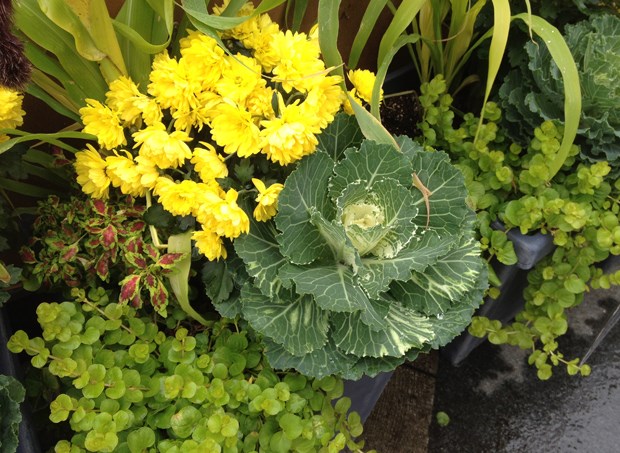Fall's crisp clean air, sunny days and cool nights make perfect weather for planting a winter hanging basket.
My garden beds are mostly full of trinkets, so I have increasingly chosen to plant containers and winter hanging baskets to enhance winter interest in my garden.
Everyone is familiar with winter containers on patios and porches filled with colourful evergreens, chrysanthemums, pansies and spring bulbs. But try growing a winter hanging basket to take colour and texture to new heights.
Here's my simple process for building a winter hanging basket.
Choose your vessel:
Any object, piece of hollowed driftwood or vessel can be used as a winter basket. It just takes some upcycling imagination. You can even reuse your current summer basket for winter. Large winter hanging baskets are especially attractive and really occupy airspace and add visual interest. By large I mean a 50-80 centimetre top diameter with a 50-60 cm height. For most homeowners, however, the standard 25-30 cm top diameter wire basket is about all that single family residential homes can support without additional structural reinforcement. Regardless of the basket type, choose one that can take a freeze and thaw without cracking or breaking into pieces. I use a 30 cm wire basket lined with moss and some driftwood.
Visualize the foliage body:
Winter hanging baskets should be planted with a majority of reliably hardy plants to form the bulk of the basket's foliage body. Save some planting space for experimental plants for fun. The Jedi plant selection mantra is to choose the right plant for the right place. For winter baskets plant selection is about the right foliage with the right hardiness. Winter basket plants don't grow much and they are subject to freezing solid while hanging in the air. So choose plants with texturally bold, interesting or colourful foliage that is evergreen or coniferous, and reliably hardy in our Zone 8 climate. Buy plants in 10 cm pots and plant tight together since no growth will occur during winter. Some evergreen perennial plants, like hellebores, will survive in a winter hanging basket but they will wilt while frozen and usually recover when temperatures warm up. Other perennials, such as evergreen grasses and ferns, also make good winter basket stuffers. Some reliable and lovely winter basket plants I recommend include heather, which blooms in winter, or those with gold or orange foliage.
Specific evergreen groundcovers like Mahonia nervosa do well when planted amongst other plants. Dwarf conifers with gold, bronze or blue foliage like Bluestar juniper make good focal points in the basket. I use very few pansies or kale because they don't stand the rain or the freeze. The planting options are limitless as long as the plant is hardy in Zone 8. However, I usually only choose plants hardy for Zone 7, which gives me a safety buffer in case our weather freezes hard and long.
Build the soil:
My soil mix for winter baskets is composed of 80 per cent bark mulch (fresh or composted), 10 per cent perlite, 10 per cent regular garden soil as a pH stabilizer, and one handful of dolomite lime. Winter baskets require drainage due to our rainy climate so don't build the soil mix as you would for a summer basket. Do not use liners to retain water for the same reason. Do not add bonemeal, fertilizer or any other additive. Feed-forcing foliage growth in winter baskets or containers is not recommended. Use moss or coco fibre mats to line the basket. Keep some extra moss to cover the top of the basket after planting to act as mulch and prevent erosion. I build the top of my basket slightly mounded to give the basket an extra visual dimension.
Find a home for the basket:
Placement of the basket is inter-related to plant selection. It is important to decide beforehand if the chosen plants are robustly hardy, or more toward the exotic and perhaps tender side of hardiness. Then the location and plant selection can be co-ordinated. Tender baskets need to be hung near the house and under the roof overhang, for example, a pansy and kale basket. Hardy broadleaved evergreen and coniferous baskets can be hung out in the rain on a pergola, gazebo, carport, tree or other structure. Use a new chain or cable to hang the basket for safety and visual appearance.
Watch the watering:
Given that the plants are still alive, watching the amount of water you give the basket is important. If the basket is hung near the house under cover of the roof, then more watering may be needed. If the basket is hung out in the open where natural rainfall will supply water, then less watering is needed.
Email [email protected]



